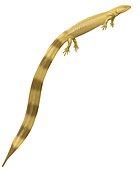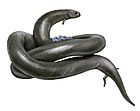Ostodolepidae
| Ostodolepidae Temporal range:
| |
|---|---|

| |
| Life restoration of Pelodosotis elongatum | |
| Scientific classification | |
| Kingdom: | Animalia |
| Phylum: | Chordata |
| Subclass: | †Lepospondyli |
| Order: | †Microsauria |
| Suborder: | †Tuditanomorpha |
| Family: | †Ostodolepidae Romer, 1945 |
| Genera | |
Ostodolepidae, also spelled Ostodolepididae, is an extinct family of Early Permian microsaurs. They are unique among microsaurs in that they were large, reaching lengths of up to 2 feet (61 cm), terrestrial, and presumably fossorial.[1] Ostodolepid remains have been found from Early Permian beds in Texas,[2] Oklahoma,[3] and Germany.[4]
Ostodolepids have elongated trunks, with small, robust limbs and shortened tails. The occiput is high, but the skull narrows toward the snout. The snout is pointed and projects past the jaw. In dorsal view, the skull is roughly triangular. The ventral temporal margin is emarginated. At the back of the skull, there is a large cavity between the supraoccipital and the skull roof. The skull is well ossified, with tight sutures between bones. The skull roof is relatively smooth, although scattered pits and grooves are usually present. There are 32 to 45 presacral vertebrae, and three sacral vertebrae.[3]
References[]
- ^ Anderson, J.S.; Scott, D.; Reisz, R.R. (2009). "Nannaroter mckinziei, a new ostodolepid 'microsaur' (Tetrapoda, Lepospondyli, Recumbirostra) from the Early Permian of Richards Spur (Ft. Sill), Oklahoma". Journal of Vertebrate Paleontology. 29 (2): 379–388. doi:10.1671/039.029.0222. S2CID 130420068.
- ^ Carroll, Robert L.; Gaskill, Pamela (1978). The Order Microsauria. American Philosophical Society. pp. 1–126. OCLC 654168566.
- ^ a b Carroll, R. L.; Gaskill, P. (1978). "The Order Microsauria". Memoirs of the American Philosophical Society. 126: 1–211. ISBN 9780871691262.
- ^ Henrici, A.C.; Martens, T.; Berman, D.S.; Sumida, S.S. (2011). "An ostodolepid 'microsaur' (Lepospondyli) from the Lower Permian Tambach Formation of central Germany". Journal of Vertebrate Paleontology. 31 (5): 997–1004. doi:10.1080/02724634.2011.596601. S2CID 129710688.
- Prehistoric amphibians of North America
- Permian amphibians
- Ostodolepids
- Cisuralian first appearances
- Cisuralian extinctions
- Prehistoric amphibian stubs



